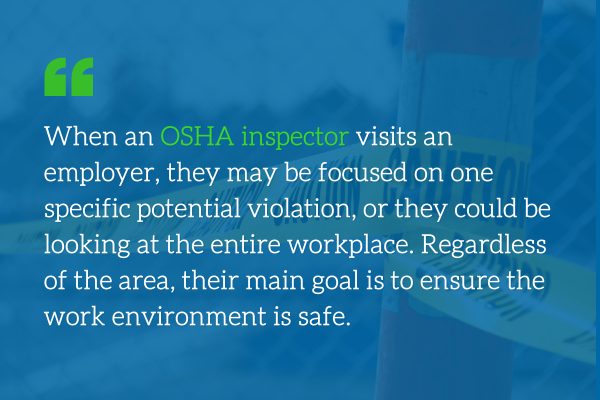5 common OSHA violations employers must be familiar with
The Occupational Safety and Health Administration (OSHA) is laser-focused on its purpose to both police and educate companies to ensure workplaces are safe and healthy for employees. When an OSHA inspector visits an employer, they may be focused on one specific potential violation, or they could be looking at the entire workplace. Regardless of the area, their main goal is to ensure the work environment is safe.
If the OSHA inspector finds a violation, it will be defined in one of six ways. However, it’s not just the penalty amount that should concern an employer. A willful or serious violation can create a negative perception with potential future customers, applicants, company branding and image, and future OSHA visits.
Willful Violations are the most serious of the violations. However, the remaining 5 are also serious concerns employers should watch out for, especially if they become repeat violations.

De Minimis
These penalties are the least severe and do not result in either a monetary fine or jail time. Instead, the OSHA inspector will make a note in the employer’s case file. These occur when the employer chooses to violate an OSHA technical rule by implementing a measure different than the one specified in the applicable OSHA standard.
Serious
A serious violation exists if there is a perceived substantial probability that potential injury, illness, or death could result from the hazard. A violation is also classed as serious if the employer knew (or should have known) about the hazard and did nothing to address it. The maximum penalty for each violation is $13,494.
Other-Than-Serious
These penalties have a direct relationship to workplace health and safety and result in a fine with the maximum penalty set at $13,494.00. Although these violations are not an immediate safety concern, they do reflect noncompliance. These may include poor recordkeeping.
Repeated
These violations are just as serious as Willful Violations. The employer is aware of the issue, has been cited for the issue, and chose to not correct the issue. OSHA may consider violations for up to five years when determining the possibility for a repeat violation. The maximum penalty for repeat violations is $134,937. If the original citation is still being contested, the employer cannot be cited again.
Failure to Abate
All violations have a deadline to be corrected. If the violation has been finalized and the employer misses the deadline to correct the issue, employers will receive a Failure to Abate. Since employers are encouraged to correct dangerous issues, OSHA may impose daily fines of up to $13,494 per day for each violation.
Because an inspector can go back five years when looking at a repeat violation, employers should always attempt to have a serious or willful penalty reclassified. Because inspectors often identify multiple issues based on one set of facts, grouping citations is another excellent strategy to decrease the number of citations and the penalty amount.





